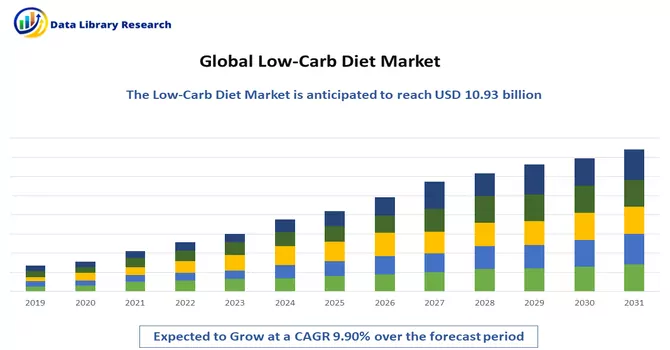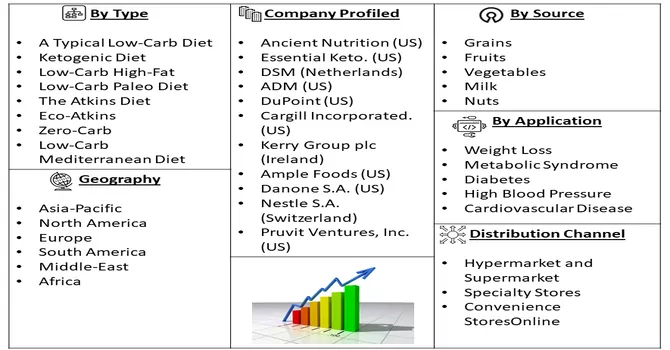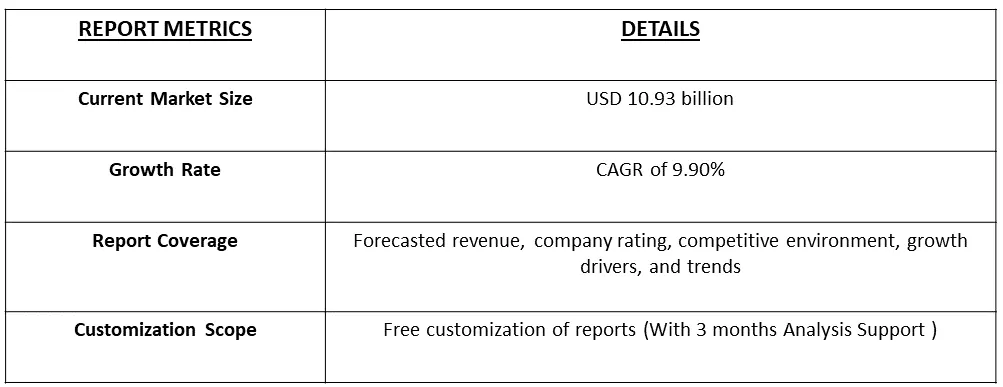The low-carb diet market is currently valued at USD 10.93 billion and is expected to undergo a CAGR of 9.90% during the forecast period, 2023-2030.

Get Complete Analysis Of The Report - Download Free Sample PDF
A low-carb diet is a dietary approach that restricts the intake of carbohydrates, with a particular focus on reducing the consumption of foods and beverages high in sugars and starches. Carbohydrates are one of the three primary macronutrients, alongside fats and proteins, and they are a significant source of energy for the body.
The popularity of low-carb diets is driven by their effectiveness in weight management, blood sugar control, and cardiovascular health improvement. The diverse range of low-carb diet options, combined with the availability of information and digital support, has made these dietary approaches increasingly appealing to a wide range of individuals seeking to improve their overall health and well-being.
The growing awareness of the health risks associated with excessive carbohydrate consumption, such as obesity and diabetes, has driven interest in low-carb diets. Moreover, restaurants and fast-food chains were increasingly offering low-carb menu items or customizable options to cater to health-conscious diners. Mobile apps and wearable devices were being used to track and manage low-carb diets. These tools helped users monitor their carbohydrate intake and nutritional choices. Thus, these market trends are fueling the market growth.
Market Segmentation: The Global Low-Carb Diet Market is Segmented By Type of Diet (A Typical Low-Carb Diet, Ketogenic Diet, and Low-Carb High-Fat (LCHF), Low-Carb Paleo Diet, The Atkins Diet, Eco-Atkins, Zero-Carb, Low-Carb Mediterranean Diet), Source (Grains, Fruits, Vegetables, Milk, Nuts, Seeds, and Legumes), Application (Weight Loss, Metabolic Syndrome, Diabetes, High Blood Pressure, and Cardiovascular Disease), Distribution Channel (Hypermarket and Supermarket, Specialty Stores, Convenience Stores, and Online) and Geography (North America, Europe, Asia-Pacific, Middle East and Africa, and South America). The report offers the value in USD million for the above segments.

For Detailed Market Segmentation - Download Free Sample PDF
Market Drivers:
Rising Prevalence of Obesity and Growing Awareness About the Benefits
There is a growing problem of obesity, as well as an increasing prevalence of Type 2 diabetes and heart diseases. People with higher levels of body fat are at a greater risk of developing diabetes. As a result, many individuals are resorting to low-carb diets as a preventive measure against obesity. According to a report from the World Health Organization (WHO) in May 2022, in the WHO European Region, more than 60% of adults and approximately 29% of boys and 27% of girls who are children are either overweight or obese. Furthermore, this report indicates that overweight and obesity are the fourth most significant risk factors for non-communicable diseases in the region, following high blood pressure, unhealthy eating habits, and smoking.
Low-carb diets may have anti-inflammatory effects. Chronic inflammation is linked to various health problems, so reducing it can be beneficial for overall health and for some individuals, a reduction in carbohydrate intake can lead to improved blood pressure control, which is essential for cardiovascular health. Thus, due to the above-mentioned reasons the market is expected to witness significant growth over the forecast period.
Research and Development Proficiencies
Research and development (R&D) efforts are critical in advancing the field of low-carb diets, improving their effectiveness, safety, and applicability to various health conditions. R&D efforts should focus on determining the short-term and long-term efficacy and safety of low-carb diets. This includes assessing their impact on weight loss, blood sugar control, lipid profiles, and overall health. R&D efforts can lead to the development of low-carb food products and alternatives that are palatable, affordable, and accessible to a wide range of individuals. This can encourage adherence to low-carb diets. Thus, due to the above-mentioned reasons the market is expected to witness significant growth over the forecast period.
Market Restraints:
High Cost of Low Carb Diet
Some low-carb diets may rely on specialty foods and ingredients that can be costly, such as almond flour, coconut oil, or grass-fed meats. These items tend to be more expensive than their high-carb counterparts. Low-carb dining options at restaurants are often more expensive than carb-heavy menu items, and dining out frequently can strain the budget. Thus, the growth of the market is expected to slow down over the forecast period.
The pandemic has heightened public awareness of the importance of a strong immune system and overall health. As a result, many individuals have turned to dietary strategies, including low-carb diets, to bolster their health and reduce the risk of underlying health conditions that can exacerbate COVID-19. With COVID-19 emphasizing the importance of a robust immune system, low-carb diets gained popularity due to their potential to support immune function and metabolic health. Some research suggested that managing blood sugar levels through low-carb diets might reduce the severity of COVID-19 symptoms. Thus, the COVID-19 pandemic has significantly impacted the low-carb diet market by driving consumer interest in health and wellness, changing dietary habits, and accelerating e-commerce trends. The market has adapted to meet the changing needs of consumers seeking to improve their immune function and metabolic health through low-carb dietary choices. As the pandemic continues to shape health-related behaviors, the low-carb diet market is likely to remain a relevant and dynamic sector of the food industry.
Segmental Analysis
The Ketogenic Diet Segment is Expected to Witness Significant Growth Over the Forecast Period
The ketogenic diet is a low-carbohydrate, high-fat dietary approach that has gained popularity for its potential health benefits. It can be an effective tool for weight loss, blood sugar control, and certain medical conditions. One of the primary reasons people turn to the ketogenic diet is for weight loss. By limiting carbohydrate intake, the body's insulin levels remain low, promoting fat-burning and helping individuals shed excess pounds. Moreover, the keto diet can be effective in stabilizing blood sugar levels, making it a potential option for individuals with type 2 diabetes or prediabetes ketones are a more efficient energy source for the brain than glucose, and some people report improved mental clarity and focus on the keto diet. Thus, owing to the above-mentioned advantages the segment is expected to witness significant growth over the forecast period.
Legumes Segment is Expected to Witness Significant Growth Over the Forecast Period
Legumes can be a valuable addition to a low-carb diet, providing a wealth of essential nutrients and health benefits. Legumes can be consumed in moderation and in combination with other low-carb foods, legumes offer a balanced and satisfying way to maintain a nutrient-rich diet while managing carbohydrate intake. Some legumes are lower in carbohydrates than others. For instance, black soybeans and green lentils are relatively low in net carbs compared to foods like chickpeas or kidney beans. The combination of protein and fiber in legumes feel full and satisfied, reducing the temptation to overeat. Thus, owing to such advantages, the segment is expected to witness significant growth over the forecast period.
Diabetes Segment is Expected to Witness Significant Growth Over the Forecast Period
Diabetes is a chronic condition characterized by elevated blood sugar levels, and diet plays a crucial role in managing this condition. A low-carb diet can be a valuable tool for individuals with diabetes to help manage their blood sugar levels and improve overall health. Carbohydrates are the macronutrient that has the most significant impact on blood sugar levels. By reducing carb intake, people with diabetes can help keep their blood sugar levels within a target range. This can be especially beneficial for those with type 2 diabetes.
Furthermore, the high number of diabetes cases is expected to drive the growth of the studied segment. For instance, according to the World Health Organization, there are over 400 million people with diabetes across the world, and its treatment constitutes around 12% of the total healthcare expenditure on a global scale. It has emerged as a global epidemic and afflicted millions worldwide. Thus, a high number of diabetes cases is expected to drive the growth of the studied market.
Hypermarket and Supermarket Segment is Expected to Witness Significant Growth Over the Forecast Period
Hypermarkets and supermarkets are large retail stores that offer a wide variety of food products, making them convenient places for individuals following a low-carb diet to shop for their groceries. These stores provide an extensive selection of fresh produce, lean proteins, and other low-carb staples, making it easier for people to maintain a healthy and balanced diet that aligns with their low-carb goals. Nuts and seeds are excellent sources of healthy fats and protein and can be a convenient, low-carb snack option. Hypermarkets and supermarkets stock a variety of nuts, such as almonds, walnuts, and pecans, as well as seeds like chia seeds and flaxseeds. Thus, the segment is expected to witness significant growth over the forecast period.
North America Segment is Expected to Witness Significant Growth Over the Forecast Period
North America has seen a rise in the popularity of low-carb diets as a response to the region's health concerns. The United States is expected to grow tremendously during the forecast period, owing to factors, such as the high prevalence of obesity and increasing awareness regarding diabetes care in the region.
In 2019, the United States witnessed a concerning rise in adult obesity rates, with more than 35% of adults classified as obese in nine states. Additionally, 31 states had obesity rates exceeding 30%, and 48 states reported rates exceeding 25%, according to data from the Behavioral Risk Factor Surveillance System (BRFSS) for that year. The state-level disparities were stark, with Mississippi and West Virginia bearing the highest adult obesity rates at a staggering 39.5%, while Colorado boasted the lowest rate at 23%. Furthermore, the Trust for America's Health organization compiled data for 2020, revealing a significant escalation in the adult obesity rate, which reached an alarming 42.4%. This marked the first time the national rate had surpassed the 40% threshold, signifying a noteworthy increase of 26% in the national adult obesity rate since 2008. The growing burden of obesity in the U.S. population has amplified the demand for low-carb diet, thereby driving the growth of the studied market over the forecast period. Thus, due to the above-mentioned factors the region is expected to witness significant growth over the forecast period.

Get Complete Analysis Of The Report - Download Free Sample PDF
The competitive landscape within the low-carb diet market offers comprehensive insights into various competitors. The information encompasses company profiles, financial performance, revenue figures, market prospects, R&D investments, recent market undertakings, global reach, manufacturing sites, production capabilities, corporate strengths and weaknesses, product introductions, product diversity, and market segment dominance. It's important to note that the details presented here pertain exclusively to the activities and strategies of these companies within the low-carb diet market.
Leading market players in the low-carb diet market include:
Recent Developments
1) In January 2022, Meal kit company Sunbasket merged with keto lifestyle company Pruvit Ventures to provide consumers with at-home, fully ketogenic meal kits. The transaction was an all-stock deal, with Sunbasket and Pruvit becoming wholly owned subsidiaries of PSB Holdings, a new holding company.
2) In June 2021, Zenwise recently launched their new line of vegan Kombucha + Supplements that contain many of the benefits in a quick daily capsule. It packs a 1-2 punch of gut-friendly probiotics. Each formula is made with a unique blend of vegan ingredients that help promote digestive health.
Q1. What is the current Low-Carb Diet Market size?
The low-carb diet market is currently valued at USD 10.93 billion.
Q2. At what CAGR is the Low-Carb Diet market projected to grow within the forecast period?
Low-Carb Diet Market is expected to undergo a CAGR of 9.90% during the forecast period.
Q3. What are the factors driving the Low-Carb Diet Market?
Key factors that are driving the growth include the Rising Prevalence of Obesity and Growing Awareness About the Benefits and Research and Development Proficiencies.
Q4. Which region has the largest share of the Low-Carb Diet Market? What are the largest region's market size and growth rate?
North America has the largest share of the market . For detailed insights on the largest region's market size and growth rate request a sample here.
Data Library Research are conducted by industry experts who offer insight on industry structure, market segmentations technology assessment and competitive landscape (CL), and penetration, as well as on emerging trends. Their analysis is based on primary interviews (~ 80%) and secondary research (~ 20%) as well as years of professional expertise in their respective industries. Adding to this, by analysing historical trends and current market positions, our analysts predict where the market will be headed for the next five years. Furthermore, the varying trends of segment & categories geographically presented are also studied and the estimated based on the primary & secondary research.
In this particular report from the supply side Data Library Research has conducted primary surveys (interviews) with the key level executives (VP, CEO’s, Marketing Director, Business Development Manager and SOFT) of the companies that active & prominent as well as the midsized organization
FIGURE 1: DLR RESEARH PROCESS

Extensive primary research was conducted to gain a deeper insight of the market and industry performance. The analysis is based on both primary and secondary research as well as years of professional expertise in the respective industries.
In addition to analysing current and historical trends, our analysts predict where the market is headed over the next five years.
It varies by segment for these categories geographically presented in the list of market tables. Speaking about this particular report we have conducted primary surveys (interviews) with the key level executives (VP, CEO’s, Marketing Director, Business Development Manager and many more) of the major players active in the market.
Secondary ResearchSecondary research was mainly used to collect and identify information useful for the extensive, technical, market-oriented, and Friend’s study of the Global Extra Neutral Alcohol. It was also used to obtain key information about major players, market classification and segmentation according to the industry trends, geographical markets, and developments related to the market and technology perspectives. For this study, analysts have gathered information from various credible sources, such as annual reports, sec filings, journals, white papers, SOFT presentations, and company web sites.
Market Size EstimationBoth, top-down and bottom-up approaches were used to estimate and validate the size of the Global market and to estimate the size of various other dependent submarkets in the overall Extra Neutral Alcohol. The key players in the market were identified through secondary research and their market contributions in the respective geographies were determined through primary and secondary research.
Forecast Model
